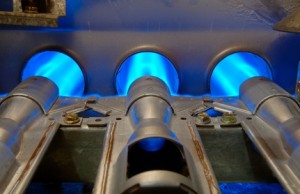 Natural gas fell for a fourth consecutive session as forecasting agencies project warmer weather ahead.
Natural gas fell for a fourth consecutive session as forecasting agencies project warmer weather ahead.
Natural gas for delivery in May slid 0.61% on Friday to $2.623 per mBtu. The contract dropped 1.82% on Friday and settled at $2.639, having previously fallen to $2.616, its lowest since last October.
According to NatGasWeather.com, natural gas demand in the US will be low-to-moderate through April 5th, with a slightly warmer weather trend for the North and East over the next seven days, while the North remains cooler.
The northern and eastern U.S. will be hit by a yet another cold blast on Monday, resulting in showers and thunderstorms over the Great Lakes, and just light snowfall over the Northeast. However, warm temperatures are projected to cover the majority of the U.S. on Tuesday, Wednesday and Thursday as high pressures dominates. Overall heating demand is expected to be lower this week as readings in the northern U.S. reach 50s and 60s, while temperatures over the southern U.S. range in the 70s and 80s.
Extreme highs will take over Texas this week with readings in the mid-90s over some areas. Cooler temperatures are expected to return to the northern and eastern U.S. on Friday and stay through the weekend. California and the rest of the West are forecast to remain warm and dry, while some rain and snow showers are projected over the Northwest.
Next week, a seasonal spring pattern will bring strong weathers systems with showers and thunderstorms across the U.S., NatGasWeather.com said. Readings over the northern U.S. are expected to be close to normal and slightly warmer over the central and southern U.S. Meanwhile, the West will be hit by slightly cooler than normal temperatures.
The Energy Information Administration reported on Thursday that US natural gas stockpiles rose by 12 billion cubic feet in the week ended March 20th, exceeding analysts’s median estimate of a build of 6-9 bcf. The five-year average withdrawal for the period is 19 billion cubic feet, while stockpiles slid by 56 bcf a year ago.
Total gas held in US storage hubs amounted to 1.479 trillion cubic feet, narrowing a deficit to the five-year average inventories of 1.673 trillion to 11.6% from 13.3% a week earlier. The surplus over year-ago stockpile levels expanded to 63.6% from 52.8% last week.
Readings
According to AccuWeather.com, New York will see temperatures peak at 56 degrees today, before gradually increasing to 63 on Friday. Tomorrows high in Chicago will reach 54, compared to the average of 53, on Thursday readings will hit 63.
Down South, Houston will see temperatures peak at 81 degrees on March 30-31st, compared to the usual 76, before they drop to 71 on Saturday. Readings in Los Angeles will max out at 80 degrees on Monday and remain in the range of 75 – 80 through the rest of the week.
Pivot points
According to Binary Tribune’s daily analysis, May natural gas futures’ central pivot point stands at $2.651. In case the contract penetrates the first resistance level at $2.685 per million British thermal units, it will encounter next resistance at $2.732. If breached, upside movement may attempt to advance to $2.766 per mBtu.
If the energy source drops below its S1 level at $2.604 per mBtu, it will next see support at $2.570. If the second key support zone is breached, the power-station fuel’s downward movement may extend to $2.523 per mBtu.
In weekly terms, the central pivot point is at $2.696. The three key resistance levels are as follows: R1 – $2.776, R2 – $2.913, R3 – $2.993. The three key support levels are: S1 – $2.559, S2 – $2.479, S3 – $2.342.





